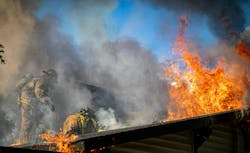For the second time this year, as I was photographing a fire, I quickly became witness to rapid fire behavior changes that led to a close call. Last month’s close call resulted in a friend being burned and, as a result, having to spend several weeks in a hospital burn center—an experience that I wish on no one. Thanks to situational awareness inside of the house fire, that member and three others survived. It could have been worse.
‘A routine fire’
I was riding with Engine 5 of the Fort Worth, TX, Fire Department for a few hours that night. When I arrived at the firehouse, I sat in the TV room with Firefighter J.B. Huddleston. We talked about how our summer had been going so far, both having returned from trips to Colorado the week before. Things were looking good that Monday evening.
After a medical run, the crew was talking about training with a new nozzle and a new member when the tones dropped for a house fire. There were reports of people possibly inside.
When we arrived, a neighbor hadn’t seen some of the children leave the house.
From the outside, it looked like a routine fire. Members needed to get a line inside of the front door to stop the fire while searching for victims; a second line would contain the outside fire. Size-ups were completed, a water supply was established, the structure was being opened up. Every window that was on the first floor had window bars. The smoke covered the second floor, so you couldn’t see the bars on those windows.
J.B. was upstairs on the nozzle along with Lt. Wes Chambers on the line. Searching the second floor of the residence was Capt. Cody Stillwell and Jordan McConnell from Truck 14.
These companies are busy. They see work and put in the time. They know their districts. They know their equipment. We’d be back at 5’s station within two hours to enjoy J.B.’s meal.
Crews were getting water on the fire, searches were underway and everything about the incident seemed normal, until it didn’t.
Terrifying
Like a scene that you would see in a movie, conditions changed, which forced the crews to bail out.
Fortunately, as Jordan searched the structure, he found the window bars that were on both sides of the second floor and removed them using hand tools. He made it to an egress ladder.
Cody’s hand pushed through the fire-weakened roof as he began his retreat.
On the other side of the roof, Wes and J.B. were out, but as fire burned in the attic below them, a mayday was called. Wes ended up on the window bars, which distributed his weight. As J.B. tried to make his way up the roof, part of his body sunk into the burning attic (see the photo in Hot Shots). He crawled up the roof using the beams for support, got over the ridgeline and was able to get to the ladder.
For a moment, Wes was alone up there. I went to tell the others, but he no longer was in view. A few seconds later, I saw that he was on the ground between the house and a vehicle, crawling out.
It was horrifying to watch it unfold. I’ve seen horrific scenes, and this ranked among the top few worst things to witness.
J.B., Wes and Cody were taken to the hospital with varying injuries. J.B. ended up in the burn center for 25 days. He is resilient and stayed positive through the entire hospitalization. His wife, Brooke, stayed strong. She rarely left his side. The firefighting family came through and took care of their brother and his family.
This fire went bad quickly, but having experienced firefighters who are “all-in” when they come to the station kept this at a close call, and I am grateful for that. I hope that others study this incident and use it as a catalyst to get out and learn.
About the Author
Peter Matthews
Editor-in-Chief/Conference Director
Peter Matthews is the conference director and editor-in-chief of Firehouse. He has worked at Firehouse since 1999, serving in various roles on both Firehouse Magazine and Firehouse.com staffs. He completed an internship with the Rochester, NY, Fire Department and served with fire departments in Rush, NY, and Laurel, MD, and was a lieutenant with the Glenwood Fire Company in Glenwood Landing, NY. Matthews served as photographer for the St. Paul, MN, Fire Department and currently is a photographer for the Fort Worth, TX, Fire Department.

